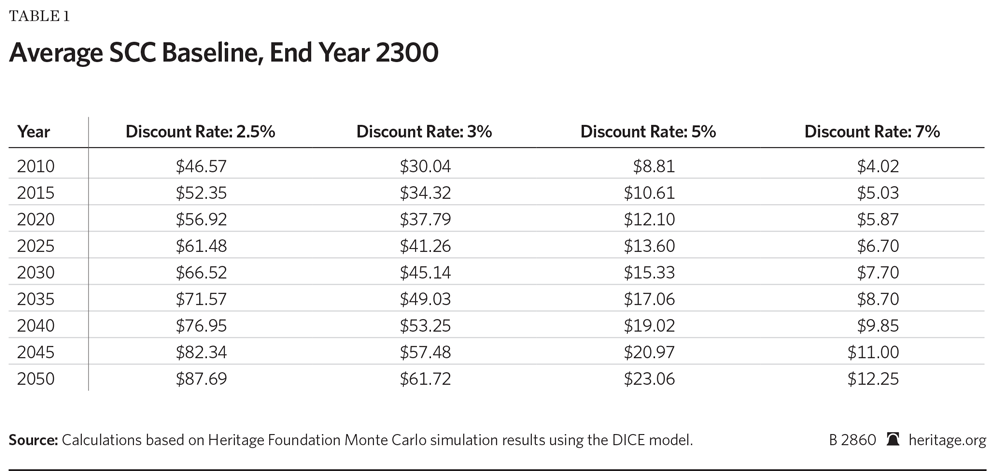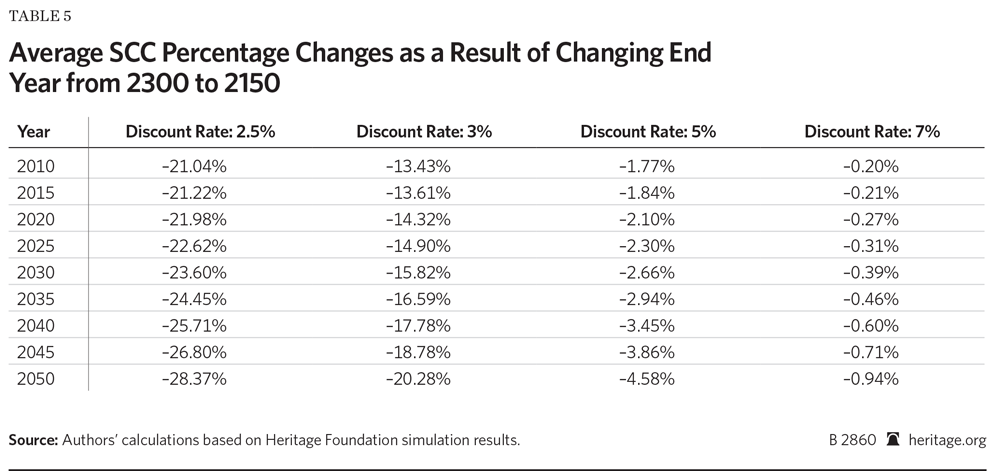Last summer I testified before a Senate subcommittee on the numerous problems with the estimates issued by the Administration’s Working Group on the Social Cost of Carbon. The Working Group’s estimates of the “social cost of carbon” were artificially inflated because of several modeling decisions that it made. Unfortunately, at the time I could only speculate as to the precise quantitative impact of their decisions, because the Working Group didn’t report the intermediate data that would be needed to tweak their findings.
However, the Heritage Foundation has conducted an independent reproduction of (part) of the Working Group’s results, and now we know just how significant its decisions were. As I will summarize in the present blog post, Heritage confirmed what I said in my testimony: Using the more appropriate modeling approach greatly reduces the “social cost of carbon,” and thus severely undercuts the Administration’s rationale for intervention in energy and transportation markets.
The Choice of Discount Rate
The most obvious problem with the Working Group’s approach is that they ignored key elements of the Office of Management and Budget (OMB) guidelines for conducting cost/benefit analysis of federal regulations. In particular, OMB clearly requires that cost/benefit analysis be performed using both a 3 percent and a 7 percent discount rate.[1] Therefore, when federal agencies (such as EPA or DOE) propose a new regulation, they must justify it economically using both rates. If they want to include the benefit of reduced carbon dioxide emissions, then they should plug in the “social cost of carbon” at both a 3 percent and a 7 percent rate.
Yet they can’t do so, because the Working Group neglected to generate a 7 percent estimate. This leads to the absurd situation of federal agencies reporting costs and benefits at a “7 percent” discount rate, then having to put in a footnote that actually those aren’t the right numbers because the relevant social cost of carbon estimates “are not available.”
In my Senate testimony, I speculated that this omission of a 7 percent discount rate was no accident. Because the (alleged) harms of carbon dioxide emissions occur in the distant future, using a higher discount rate will reduce the present value of those projected damages. Had the Working Group done the obviously correct thing by reporting a 7 percent estimate of the “social cost of carbon”—so that federal agencies wouldn’t need to fudge with footnotes when reporting their regulatory analyses at a “7 percent” discount rate—then the public would have gained some insight into just how dubious this whole enterprise was.
However, I couldn’t say exactly how much the reported social cost of carbon would fall, had the Working Group used a 7 percent figure, because they didn’t save their intermediate results. In other words, outside analysts would have to run the entire computer simulations from scratch, if they wanted to either double check the Administration’s numbers or tweak the inputs to see how much it affected the result.
Heritage Foundation Runs Nordhaus’ DICE Model
Fortunately the Heritage Foundation—especially its programmer Kevin Dayaratna—has been able to get one of the three Administration-chosen models up and running. Specifically, they started with William Nordhaus’ DICE model. After reproducing the Working Group’s results, Heritage then tweaked some of the parameters to see how it affected the reported “social cost of carbon” for various years. The interested reader can click through to read Heritage’s full report, but in this post I want to focus on just two of their findings.
First let’s see what happens when we include a discount rate of 7 percent. The table below shows what Heritage found:
Source: Heritage Foundation
The above results are striking. The headline reports issued from the Working Group looked at the 3 percent figure, and indeed this is the number used to this day by federal agencies even when they are conducting cost/benefit analyses at the “7 percent discount rate” level. (To be clear, the Working Group blended the results of three different models, only one of which was the DICE model. So agencies aren’t literally using the 3 percent SCC estimated produced by DICE alone, but rather a composite number. However, the pattern holds true in the other models as well, where the 7 percent figure is much lower than the 3 percent figure.)
The table above from Heritage shows just how significant this decision is. For example, in the year 2020, the estimated social cost of carbon using a 3 percent discount rate is about $38/ton of carbon dioxide. In contrast, the SCC in that same year at the 7 percent discount rate falls to about $6/ton, a drop of almost 85 percent. It’s no wonder that the Working Group entirely neglected to report its SCC estimates at the 7 percent rate, or why federal agencies insist on using the 3 percent figure (when reporting cost/benefit results at the “7 percent” rate) even though a closer 5 percent figure is available to them.
Changing the Time Horizon
Before closing, I want to highlight another aspect of the Heritage analysis. The public has been led to believe that there are imminent catastrophes from climate change damage lurking around the corner, unless we take immediate action. Yet in reality, the way to generate large values of the social cost of carbon is to speculate enormous damages that don’t occur until decades or even centuries in the future.
The Heritage Foundation provided a nice illustration of this in the following table:
Source: Heritage Foundation
To appreciate what the above table is showing us, first we need the context: The Working Group ran its three chosen computers models through the year 2300, in order to calculate the SCC for various years. So for example, a ton of carbon dioxide issued in the year 2020 would (in the computer simulations) lead to higher global temperatures and (eventually)[2] higher climate change damages, rising through the year 2300. Then the increment in damages for each year would be discounted back to the year 2020, in order to calculate the cumulative net present value of the future damages. This number is the social cost of carbon, for the discount rate used.
Now the Working Group didn’t actually report the annual estimates of damage from climate change; instead it just reported the summed-up social cost of carbon estimates for various years. That means that we don’t really know, for example, how much of the “social cost of carbon” for the year 2020 is due to near-term damages, versus enormous damages that the computer projects will occur in the year, say, 2280.
The reason such considerations are important is that most people in the public understand that making federal policy on the basis of computer simulations about what will happen centuries in the future is rather dubious, to say the least.
In this context, then, look again as the table immediately above. It shows that if we shorten our time horizon from the year 2300 back to the year 2150, then we lose a large fraction of the estimated “social cost of carbon” at the lower discount rates. For example, take the DICE model’s estimate of the social cost of carbon for the year 2050, at a 2.5 percent discount rate, which is about $88/ton (not shown in the table above). The table above shows that 28.37% of this amount is being generated by damages that occur after the year 2150.
In other words, if Americans are alarmed at reports that the social cost of carbon could be as high as $88/ton by 2050, they should realize that about $25 of that figure is being generated by damages that won’t occur until the time frame of 2150 – 2300. Notice that nobody here is “denying the science” of climate change; we’re just making sure the public understands how the Administration is generating their scary numbers. Remember that the Administration needs large, scary numbers to help justify new, burdensome, and incredibly expensive regulations.
Conclusion
Despite the confident rhetoric of the Administration and its allies, the economic case for aggressive federal action against carbon dioxide emissions is dubious. The fact that the Working Group had to ignore a clear OMB guideline when issuing estimates of the “social cost of carbon” gave us a hint of the problems. The Heritage Foundation’s analysis of the DICE model gives quantitative specificity to the suspicions I voiced back during my Senate testimony.
[1] The interested reader can see the full discussion at OMB Circular A-4, by searching the document for the phrase “discount rate.”
[2] I wrote “(eventually)” higher damages because in the FUND model, global warming actually leads to net benefits in the first few decades, after which it turns to net damages.





